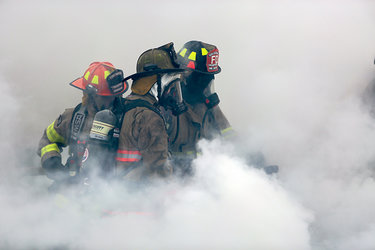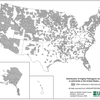Firefighters push back on OSHA proposal, citing high costs, excessive paperwork and training
Enterprise file photo — Michael Koff
In a purposeful fog, Adam Molesky, a New York State fire instructor, at center, works with local firefighters, Jonathan Donohue of Guilderland, right, and Kyle Dunagan of Fort Hunter to put out a car fire during training exercises. Added training requirements being proposed by OSHA are considered burdensome by already overburdened volunteers.
Firefighters in all manner of employment have strung together a set of small victories as of late as they attempt to push back on a proposed federal standard they say would hamstring their already difficult jobs.
In the works for about two decades, the federal Department of Labor’s Occupational Safety and Health Administration has proposed bringing the rule, known as the fire brigade standard, 29 CFR 1910.156, in line with best practices established by the Federal Emergency Management Agency.
The update to the over-40-year-old fire-safety standard has its roots in the terrorist attacks of Sept. 11, 2001, after which gaps in protections for emergency responders were identified; the actual update process began in about 2007.
Known as the Emergency Response Standard, the rule would extend the original firefighter safety standard to other first responders, like those in the emergency medical services — and to volunteers who don’t collect a check fighting fires for a living.
The act that established OSHA’s jurisdiction over America’s private-sector workforce excluded state and local government employees from the agency’s authority. However, the 1970 legislation also allowed state governments to establish, implement, and enforce their own federally-approved workplace safety rules, if they were at least as effective as OSHA’s private-sector protections.
These state plans can cover either private and non-federal, public-sector employees, or a state could adopt an OSHA-approved plan with oversight of only state and local government workers, as is the case in New York state.
And, while there are places in the proposed Emergency Response Standard where OSHA states the new regulations wouldn’t extend to the nation’s volunteer fire service departments, that wouldn’t be the case in New York, where the state’s workplace safety standards have historically defined volunteer firefighters as employees.
Emergency Response Standard
The proposed standard, which runs some 250 tiny-lettered pages, states, among other things, that:
— Employers must develop and implement a written Emergency Response Program addressing various aspects of emergency response, including risk management, medical evaluations, training, and equipment;
— A comprehensive risk management plan is required to identify, evaluate, and mitigate hazards associated with emergency response activities;
— Medical evaluations and surveillance of first responders is mandatory, which is meant to ensure their fitness for duty and address health risks associated with the work;
— Health and fitness programs meant to help emergency workers maintain physical fitness are to be established; and
— Comprehensive training requirements are to be established, including initial, ongoing, refresher, and vocational training, in addition to an annual skills checks.
Uproar
Announcement of the proposed regulation came at the end of last year, which was followed by publication in the Federal Register two months later, an act that was met with quick and near-universal criticism from those whom the updated standard was meant to protect.
The uproar appears to have worked in that comments on the proposed standard process have been extended long past its initial end date.
When the proposed regulation was published in February, the comment period was meant to run through May 6, but OSHA, according to the agency, received a number of extension requests from stakeholders explaining “that they need additional time to carefully review the questions in the [Notice of Proposed Rulemaking] and gather data.”
OSHA extended the deadline twice more, at the end of March, allowing comments to be submitted until June 21, and on June 11, when the period was extended until July 22.
The health and safety administration estimated it would take each firefighter 355 hours of additional training to get brought up to speed with its proposed emergency standard, with fewer hours for smaller departments. Depending on the current level of an EMS employee’s certification, the agency estimated one-time, upfront training could take between 48 and over 533 hours.
Local numbers
Among the volunteer fire departments in Guilderland, only Westmere, with 61, has more than 50 active firefighters, while six other volunteer departments have collectively about 285 active firefighters.
The three departments serving the Hilltowns count close to 130 active volunteers. In New Scotland, there are a combined 85 active volunteers in the other two departments serving the town, while the Voorheesville Fire Department, according to federal fire administration data, has 46 active volunteer firefighters.
When it came to extra dollars and cents, OSHA estimated the average annual additional cost of complying with its new standard at about $26,000 for departments with fewer than 25 firefighters, $37,000 for departments with between 25 and 49, and $48,000 for departments with 50 and 99 responders.
In a letter to the agency, the Town of Guilderland Fire Chiefs Association wrote that the “proposed changes to the OSHA regulations [would] add 25 new information collection requirements (emergency/risk planning, vehicle procedures, incident planning, medical/health records).
“As written these changes would require the District to hire a full-time resource to ensure compliance with this unfunded mandate. Each district would require at least one full-time position at an estimated cost of $100,000 for salary and benefits.”
During a July 9 trustee workshop, Voorheesville Deputy Mayor Richard Berger told his fellow board members he was informed by the village fire department that property owners in Voorheesville could expect to see their property tax bill increase by nearly half, about 47 percent, if OSHA adopted the standard as proposed.
Training
Scott Jill, who chairs the Guilderland Fire District’s commissioners board, in a separate letter to OSHA explained his district department’s training.
“All exterior firefighters are required to complete the 79-hour New York State Basic Exterior Firefighting Operations course, Jill wrote. “Upon completion, those members who want to become an interior firefighter complete the 50-hour New York State Interior Firefighting Operations course.”
Jill wrote Guilderland fire members “often continue to complete other State-offered courses such as firefighter survival, pump operations, truck company operations, and extrication,” and that all “of these courses are completed in the evening and on weekends after the member finished working their full-time jobs.”
He then wrote how the department “develops pre-plans and conducts on-site visits of complex properties located within the District to ensure that members are prepared to respond to emergency incidents,” and the department “relies on mutual aid departments to provide specialized services such as rapid intervention team (RIT), advanced hazardous material response, and wildfire response.”
Each of the areas, he wrote, require advanced specialized training.
Addressing OSHA’s proposed additional training requirements, the Guilderland chiefs explained to the federal regulator how their respective departments already maximized members’ limited time and considerable talent.
Guilderland’s all-volunteer fire departments “ensures that its members are trained to respond to all types of incidents,” but each also “focuses on specialty areas such as rapid intervention team, heavy extrication, ladder operations, water supply, and wildfire response.”
This approach, according to the chiefs, “enables the Town Fire Departments as a whole to maximize the limited time that members are available for training. Mutual aid training allows departments to conduct joint training exercises to ensure readiness for potential incidents.”
Finances
While the local department letters to OSHA made mention of the increased costs that would be incurred with adoption, other departments from across the country sought to make it clear how much they would be impacted financially by the new OSHA standard.
The North Canton United Fire Department of North Carolina has an annual budget of $375,000 and 23 volunteer firefighters who respond to 900 calls a year.
The cost to implement its rules, the department told OSHA, would take $3 million:
— About $197,250 for personal protective equipment (PPE) and self-contained breathing apparatuses (SCBA);
—About $75,290 for training;
— Approximately $2.7 million for vehicle replacement and maintenance; and
— $23,500 to pay for more thorough medical evaluations.
In North Caolina’s Rockingham County, the Williamsburg Volunteer Fire Department and Rescue squad’s annual budget is $324,000. The department’s 45 volunteers respond to over 900 calls each year.
Compliance would cost about $4.7 million:
— About $267,00 for PPE and(SCBA;
—About $503,000 for training;
— More than $3.8 million for vehicle replacement and maintenance; and
— About $37,000 for additional medical exams.



